|
Every Tuesday, a new Fermilab Director's Corner appears in Fermilab Today, Fermilab's daily email publication for employees, users and subscribers.
Fermilab Director's Corner Archive – 2009
| Dec.22, 2009 |
| Happy holidays! |
|
 As we close this year, I wish you every happiness to you, your family and friends and a prosperous New Year!
As we close this year, I wish you every happiness to you, your family and friends and a prosperous New Year!
2009 was very good year for us and you should be proud of all the laboratory's accomplishments across a wide front. The Accelerator Complex broke all previous records and we obtained beautiful results from the Tevatron and the neutrino programs. The non-accelerator experiments also did very well with new results in the dark matter searches and the Pierre Auger observatory. The LHC and CMS turn on was very successful. We advanced considerably in implementing the future program with strong support by the Department of Energy Office of High Energy Physics. Minerva is nearly complete and DES and NOvA are well on their way. MicroBooNE is progressing well, Mu2e has CD-0 and LBNE is on track to get CD-0 soon – these will be the anchors of the program later in the decade. The SCRF and ILC R&D continue successfully. We made progress on the design of Project X with exciting new ideas and we will host the national program on muon collider and neutrino factory R&D. Our national and international collaborations are developing strongly and will be essential for the success of our future program. Our safety record that was already quite strong has improved noticeably in the last three months. We have started a series of improvements in operations that will allow us to be more efficient and rigorous in the delivery of projects and programs. And we even know how to have fun as we demonstrated at the lab-wide pot-luck party with performances last week, including skits written and acted out by talented citizens of our laboratory.
|
| Dec.16, 2009 |
| Short visit to Perú |
|
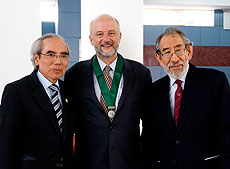 During the last two weeks I visited Perú for the first time in more than 20 years. I found a country much changed and developing quickly. I grew up in Perú and left in 1960 to study in the US at a time when it would have been nearly impossible to study physics in Perú. While Perú has a long way to go in physics, the drive to understand and promote science generally is there, thanks to the heroic effort of a few devoted academics over the last decades. In high energy physics both the Pontificia Universidad Católica del Peru (PUCP) and the Universidad Nacional de Ingeniería (UNI) have groups working at Fermilab in the Minerva collaboration. My visit was an opportunity for building new relations and promoting the importance of science and technology.
During the last two weeks I visited Perú for the first time in more than 20 years. I found a country much changed and developing quickly. I grew up in Perú and left in 1960 to study in the US at a time when it would have been nearly impossible to study physics in Perú. While Perú has a long way to go in physics, the drive to understand and promote science generally is there, thanks to the heroic effort of a few devoted academics over the last decades. In high energy physics both the Pontificia Universidad Católica del Peru (PUCP) and the Universidad Nacional de Ingeniería (UNI) have groups working at Fermilab in the Minerva collaboration. My visit was an opportunity for building new relations and promoting the importance of science and technology.
|
| Dec. 8, 2009 |
| Notable events |
|
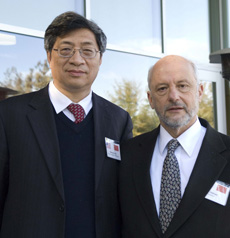 The last couple of weeks we have had some notable events, first among them the smooth turn-on of the LHC. Detectors are now collecting data at 0.9 TeV center-of-mass energy, a very important step in bringing the detectors and the machine to full performance. Both beams were brought to a record energy of 1.18 TeV per beam about a week ago, making the LHC the highest-energy collider in the world. There is clearly much yet to do to reach the full potential of the LHC, but these first steps augur well for the future. Congratulations to our colleagues at the LHC and to those at Fermilab who have worked so hard to get the accelerator and the CMS experiment ready for data.
The last couple of weeks we have had some notable events, first among them the smooth turn-on of the LHC. Detectors are now collecting data at 0.9 TeV center-of-mass energy, a very important step in bringing the detectors and the machine to full performance. Both beams were brought to a record energy of 1.18 TeV per beam about a week ago, making the LHC the highest-energy collider in the world. There is clearly much yet to do to reach the full potential of the LHC, but these first steps augur well for the future. Congratulations to our colleagues at the LHC and to those at Fermilab who have worked so hard to get the accelerator and the CMS experiment ready for data.
Another important event where kudos are due is the outstanding safety performance of the laboratory for the last two months. With only one recordable (TRC) case and zero days away and restricted (DART) cases, the laboratory, albeit with a small statistical sample, is back to the performance of 2008. With the winter season upon us and the greater chance of slips and falls due to icy conditions, I urge you to exercise good judgment in all your activities, both at the laboratory and away from the laboratory.
|
| Dec. 1, 2009 |
| Building a better workplace |
|
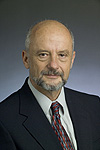 The report from the focus groups that we undertook earlier this year showed that, overall, employees think Fermilab is a good place to work. They also pointed to areas for improvement. Since I talked with you at an all-hands meeting last June we have taken a number of actions to address issues the focus groups raised. Now I'd like to ask your help with the next step, forming an Employee Advisory Group to provide advice and insight to me and other senior managers as we move forward in making Fermilab an even better place to work.
The report from the focus groups that we undertook earlier this year showed that, overall, employees think Fermilab is a good place to work. They also pointed to areas for improvement. Since I talked with you at an all-hands meeting last June we have taken a number of actions to address issues the focus groups raised. Now I'd like to ask your help with the next step, forming an Employee Advisory Group to provide advice and insight to me and other senior managers as we move forward in making Fermilab an even better place to work.
What have we done so far? Several focus-group findings concerned Human Resources. In response, the HR Department, under the leadership of Section Head Kay Van Vreede, has developed a master plan to improve customer relations and customer service. Some actions that HR is taking:
|
| Nov. 17, 2009 |
| Over the top |
|
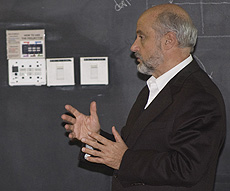 Last week activities at Fermilab were at a peak. Not only was the experimental program in full swing, but we had two important workshops, one on the experimental program of Project X and the other on the experimental reach of a possible muon collider. To top it all we had the fall meeting of the Program Advisory Committee with one of its busiest agendas ever.
Last week activities at Fermilab were at a peak. Not only was the experimental program in full swing, but we had two important workshops, one on the experimental program of Project X and the other on the experimental reach of a possible muon collider. To top it all we had the fall meeting of the Program Advisory Committee with one of its busiest agendas ever.
The first workshop dealt with the physics opportunities of Project X. We have analyzed two "initial configurations" for Project X, IC-1 and IC-2. The IC-1 uses a pulsed linac with millisecond-long pulses at 2.5 Hz - a linac that is very similar to the ILC. This linac would produce an 8 GeV proton beam to be injected into the existing Recycler, which in turn would feed the Main Injector.
|
| Nov. 10, 2009 |
| 2010 is around the corner |
|
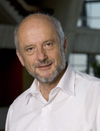 Between the colloquium at Johns Hopkins last Thursday and a presentation to the URA Board of Trustees yesterday back in Washington, D.C., I made a quick trip to Irvine, Calif., to make a presentation to the National Academy of Science's Board on Physics and Astronomy. My presentation was on the Fermilab program. It was part of an analysis by the BPA on the results of EPP2010, the broad NAS committee that made recommendations for the development of particle physics in the U.S. While it seems yesterday that we were dealing with EPP2010 — and 2010 was a few years away — now 2010 is around the corner. EPP 2010 was quite different from other NAS committee in that it included notable individuals outside our field. It was charged to prioritize opportunities and develop recommendations for the next 15 years. Dennis Kovar, head of the Office of High Energy Physics in DOE, Mel Shochet, chair of HEPAP, and Barry Barish among others, also made presentations to the BPA at Irvine.
Between the colloquium at Johns Hopkins last Thursday and a presentation to the URA Board of Trustees yesterday back in Washington, D.C., I made a quick trip to Irvine, Calif., to make a presentation to the National Academy of Science's Board on Physics and Astronomy. My presentation was on the Fermilab program. It was part of an analysis by the BPA on the results of EPP2010, the broad NAS committee that made recommendations for the development of particle physics in the U.S. While it seems yesterday that we were dealing with EPP2010 — and 2010 was a few years away — now 2010 is around the corner. EPP 2010 was quite different from other NAS committee in that it included notable individuals outside our field. It was charged to prioritize opportunities and develop recommendations for the next 15 years. Dennis Kovar, head of the Office of High Energy Physics in DOE, Mel Shochet, chair of HEPAP, and Barry Barish among others, also made presentations to the BPA at Irvine.
|
| Nov. 3, 2009 |
| Accelerators for America's Future |
|
 Last week some 400 attendees participated in the Symposium on Accelerators for America's Future in Washington, D.C. They represented scientists, engineers and policy makers involved in the development and uses of accelerators: scientific research, medicine, new concepts for energy and the environment, industrial processes, security applications and education. The one-day symposium was followed by a two-day workshop to explore in detail the challenges posed by the needs of future accelerators. The meeting was remarkable for covering the wide scope of accelerator applications.
Last week some 400 attendees participated in the Symposium on Accelerators for America's Future in Washington, D.C. They represented scientists, engineers and policy makers involved in the development and uses of accelerators: scientific research, medicine, new concepts for energy and the environment, industrial processes, security applications and education. The one-day symposium was followed by a two-day workshop to explore in detail the challenges posed by the needs of future accelerators. The meeting was remarkable for covering the wide scope of accelerator applications.
|
| Oct. 27, 2009 |
| PASAG |
|
 Last week the High Energy Physics Advisory Panel (HEPAP) received the report of the Particle Astrophysics Scientific Assessment Group (PASAG) and approved it unanimously for transmission to DOE and NSF. Professor Steve Ritz of the University of California Santa Cruz chaired the assessment group. They worked over the last several months on its charge to "re-examine current and proposed U.S. research capabilities in particle astrophysics ... needed to achieve an optimum program in the context of various budget scenarios."
Last week the High Energy Physics Advisory Panel (HEPAP) received the report of the Particle Astrophysics Scientific Assessment Group (PASAG) and approved it unanimously for transmission to DOE and NSF. Professor Steve Ritz of the University of California Santa Cruz chaired the assessment group. They worked over the last several months on its charge to "re-examine current and proposed U.S. research capabilities in particle astrophysics ... needed to achieve an optimum program in the context of various budget scenarios."
|
| Oct. 20, 2009 |
| Two meetings |
|
 Last week we had two important meetings. The first one took place on Monday at the University of Chicago. It was the sixth science collaboration meeting between Argonne National Laboratory, Fermilab and the University of Chicago, with some 90 participants discussing opportunities for collaboration among our three institutions. Closer collaboration with Argonne and University of Chicago was one of the primary motivations for the creation of the Fermi Research Alliance, and the positive results are very much in evidence.
Last week we had two important meetings. The first one took place on Monday at the University of Chicago. It was the sixth science collaboration meeting between Argonne National Laboratory, Fermilab and the University of Chicago, with some 90 participants discussing opportunities for collaboration among our three institutions. Closer collaboration with Argonne and University of Chicago was one of the primary motivations for the creation of the Fermi Research Alliance, and the positive results are very much in evidence.
|
| Oct. 13, 2009 |
| NNN09 |
|
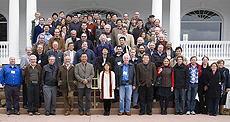 The International Workshop on Next Generation Nucleon Decay and Neutrino Detectors, NNN09, took place in Estes Park, Colorado, Oct. 8-10. This was the tenth in a series of meetings that have taken place annually around the world, focusing on experiments that go beyond the reach of current projects and the theoretical work that motivates and describes such advances. An additional purpose of these meetings is to build international collaborations. The meeting had strong participation from the U.S., Japan and Europe. I gave the closing talk at the conference.
The International Workshop on Next Generation Nucleon Decay and Neutrino Detectors, NNN09, took place in Estes Park, Colorado, Oct. 8-10. This was the tenth in a series of meetings that have taken place annually around the world, focusing on experiments that go beyond the reach of current projects and the theoretical work that motivates and describes such advances. An additional purpose of these meetings is to build international collaborations. The meeting had strong participation from the U.S., Japan and Europe. I gave the closing talk at the conference.
|
| Oct. 6, 2009 |
| Testimony |
|
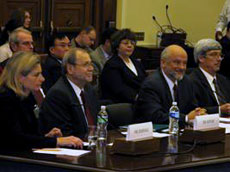 Last week was a busy week for me in Washington, DC. I visited DOE officials in the Office of Science on Tuesday and attended the unveiling of the official portrait of Secretary Bodman. All the official portraits of past secretaries hang together in the corridor outside the DOE Secretary's Office. On Wednesday I visited several Congressional offices and the Office of Management and Budget. Finally, on Thursday, I was a witness along with Dennis Kovar, Harvard physicist Lisa Randall and Jefferson Laboratory Director Hugh Montgomery in front of the Energy and Environment Subcommittee of the House Science and Technology Committee. Two of the Illinois members of the Subcommittee were present: Representative Daniel Lipinski, who presided over the committee for part of the hearing, and Representative Judy Biggert, both great friends of science and Fermilab. You can find the written testimony and, eventually, the Web cast here.
Last week was a busy week for me in Washington, DC. I visited DOE officials in the Office of Science on Tuesday and attended the unveiling of the official portrait of Secretary Bodman. All the official portraits of past secretaries hang together in the corridor outside the DOE Secretary's Office. On Wednesday I visited several Congressional offices and the Office of Management and Budget. Finally, on Thursday, I was a witness along with Dennis Kovar, Harvard physicist Lisa Randall and Jefferson Laboratory Director Hugh Montgomery in front of the Energy and Environment Subcommittee of the House Science and Technology Committee. Two of the Illinois members of the Subcommittee were present: Representative Daniel Lipinski, who presided over the committee for part of the hearing, and Representative Judy Biggert, both great friends of science and Fermilab. You can find the written testimony and, eventually, the Web cast here.
|
| Sept. 29, 2009 |
| An unusual visit |
|
 The 22nd International Conference on Weak Interactions and Neutrinos took place in Perugia last week. The conference was the last in a series that started in the early '70s at a time when the principal thrust in particle physics was the study of the strong interaction. Today, weak interactions and neutrinos are studied by many physicists around the world. Discoveries in this area have been essential in shaping the Standard Model of particle physics and in the case of the discovery of neutrino masses provide the only definitive glimpse beyond the Standard Model.
The 22nd International Conference on Weak Interactions and Neutrinos took place in Perugia last week. The conference was the last in a series that started in the early '70s at a time when the principal thrust in particle physics was the study of the strong interaction. Today, weak interactions and neutrinos are studied by many physicists around the world. Discoveries in this area have been essential in shaping the Standard Model of particle physics and in the case of the discovery of neutrino masses provide the only definitive glimpse beyond the Standard Model.
Even though Fermilab is categorized as a single-program laboratory, we have over 40 separate "Budget and Reporting" categories. Each B&R category funds a particular kind of laboratory activity and must be tracked separately. An activity supported by a given category must fit within the allocation budgeted by OHEP. Each DOE program manager is in charge of some specific budget categories and, as part of his or her responsibilities, is called to optimize that kind of program or activity across all DOE-supported laboratories and universities.
|
| Sept. 22, 2009 |
| WIN09 |
|
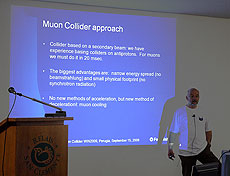 Last Monday and Tuesday we hosted nine program managers from DOE's Office of High Energy Physics. This was not one of our "normal" reviews in which judgments are drawn on how we are performing against goals set by OHEP. This was an informal visit for both the program managers in OHEP and our own managers to get to know each other and to become familiar with the issues we confront in managing a complex enterprise like Fermilab.
Last Monday and Tuesday we hosted nine program managers from DOE's Office of High Energy Physics. This was not one of our "normal" reviews in which judgments are drawn on how we are performing against goals set by OHEP. This was an informal visit for both the program managers in OHEP and our own managers to get to know each other and to become familiar with the issues we confront in managing a complex enterprise like Fermilab.
|
| Sept. 15, 2009 |
| Gran Sasso-Fermilab meeting |
|
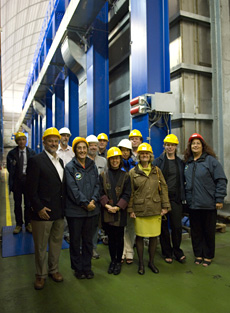 Last Friday and Saturday a group from Fermilab and our users held a meeting to explore future collaborations with the Gran Sasso National Laboratory and their users. There is much to learn from the experience at Gran Sasso, today the largest underground laboratory in the world, with the most extensive program including very sizeable detectors. The majority of the experiments at Gran Sasso are concentrated on neutrinos (from both accelerator and natural sources) and on dark matter searches, both topics of great interest to our Fermilab program. The meeting coincided with the transition from Gran Sasso Laboratory Director Eugenio Coccia to Lucia Votano, so we had the privilege of having them both at our meeting. The poster for the meeting came from one of the drawings the children at our daycare centers exchanged following the earthquake in the Gran Sasso area in April.
Last Friday and Saturday a group from Fermilab and our users held a meeting to explore future collaborations with the Gran Sasso National Laboratory and their users. There is much to learn from the experience at Gran Sasso, today the largest underground laboratory in the world, with the most extensive program including very sizeable detectors. The majority of the experiments at Gran Sasso are concentrated on neutrinos (from both accelerator and natural sources) and on dark matter searches, both topics of great interest to our Fermilab program. The meeting coincided with the transition from Gran Sasso Laboratory Director Eugenio Coccia to Lucia Votano, so we had the privilege of having them both at our meeting. The poster for the meeting came from one of the drawings the children at our daycare centers exchanged following the earthquake in the Gran Sasso area in April.
The laboratory’s infrastructure is very impressive, with great attention paid to the safety of underground operations. The horizontal access to the laboratory from a tunnel that goes through the mountain is easy and uncomplicated. The laboratory supports large detectors such as ICARUS, OPERA and Borexino, but in its present configuration it cannot support the massive detectors needed for future long-baseline neutrino experiments such as the proposed LBNE experiment. Yet the technologies used in Gran Sasso, such as the pioneering work in liquid-argon TPCs used in ICARUS, the radio-purity techniques and low background environments for dark matter searches, and the study of solar neutrinos are directly applicable to our future work.
|
| Sept. 8, 2009 |
| An unusual visit |
|
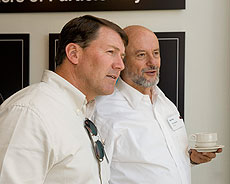 A few times a year we have visits from elected officials. But it is an unprecedented event when an elected official spends two days at the laboratory together with his staff understanding what we do in great detail, not only our scientific experiments but also the many other aspects of our institution: the education program, the funding situation, the lecture and arts series, our efforts with the neighbors, the prairie restoration, and the bison herd to name a few.
A few times a year we have visits from elected officials. But it is an unprecedented event when an elected official spends two days at the laboratory together with his staff understanding what we do in great detail, not only our scientific experiments but also the many other aspects of our institution: the education program, the funding situation, the lecture and arts series, our efforts with the neighbors, the prairie restoration, and the bison herd to name a few.
This happened two weeks ago just before I left on vacation when we were honored by the visit of Governor Michael Rounds of South Dakota. From the deep interest in science and education evident during his visit, we could immediately understand the critical role that he has played in positioning the Homestake Mine to become the US deep underground laboratory.
|
| Aug. 25, 2009 |
| Lepton Photon 2009 |
|
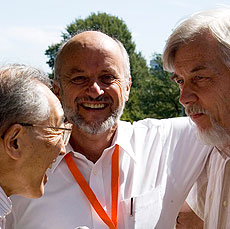 Hamburg, Germany was the venue for the XXIV International Symposium on Lepton Photon Interactions at High Energies, http://lp09.desy.de/. From August 22 through the 27 physicists from around the world congregated to hear and share the latest physics results and plans for the future. This year’s symposium follows the one in Daegu, Korea in 2007 and the one in Uppsala, Sweden in 2005. Hamburg, with its superposition of baroque and modern architecture, the most bridges of any city in the world, a modern conference center, excellent public transportation and its citizens out and about enjoying the all –too-brief summer, provided a great venue for the meeting.
Hamburg, Germany was the venue for the XXIV International Symposium on Lepton Photon Interactions at High Energies, http://lp09.desy.de/. From August 22 through the 27 physicists from around the world congregated to hear and share the latest physics results and plans for the future. This year’s symposium follows the one in Daegu, Korea in 2007 and the one in Uppsala, Sweden in 2005. Hamburg, with its superposition of baroque and modern architecture, the most bridges of any city in the world, a modern conference center, excellent public transportation and its citizens out and about enjoying the all –too-brief summer, provided a great venue for the meeting.
|
| Aug. 18, 2009 |
| Visitors from Washington |
|
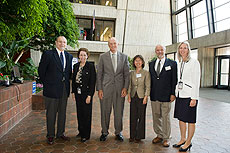 Last Thursday we had the honor of hosting DOE Office of Science Director Bill Brinkman, Deputy Director Pat Dehmer, Office of High Energy Physics Director Dennis Kovar, and Senior Advisor Steve Binkley. When we go to Washington, we can discuss many things in the abstract, but nothing beats bringing visitors to the laboratory in person, where they can see the facilities and the site and feel the enthusiasm of all who work here. Of course, Dennis Kovar owns the joint; he has been here several times and knows us well. But for the other distinguished visitors, this was their first visit, and first impressions count.
Last Thursday we had the honor of hosting DOE Office of Science Director Bill Brinkman, Deputy Director Pat Dehmer, Office of High Energy Physics Director Dennis Kovar, and Senior Advisor Steve Binkley. When we go to Washington, we can discuss many things in the abstract, but nothing beats bringing visitors to the laboratory in person, where they can see the facilities and the site and feel the enthusiasm of all who work here. Of course, Dennis Kovar owns the joint; he has been here several times and knows us well. But for the other distinguished visitors, this was their first visit, and first impressions count.
|
| Aug. 11, 2009 |
| Turning the LHC back on |
|
 The recent announcement by CERN Director Rolf Heuer that the LHC will be ready to take beam again by mid- November is welcome news. The decision to run the LHC at a total center-of-mass energy of 7 TeV for enough time to provide an interesting body of data to the experiments while making sure every aspect of the machine is understood is just the right approach. The energy is high enough to open up important new discovery potential. From everything that we know today, higher energies to 10 TeV will be possible later in the run, once every aspect of the operations is proven. During the last year CERN has done a formidable job of uncovering possible future problems and putting repairs in place to avoid them. We have contributed some of our best Fermilab experts to help with this task.
The recent announcement by CERN Director Rolf Heuer that the LHC will be ready to take beam again by mid- November is welcome news. The decision to run the LHC at a total center-of-mass energy of 7 TeV for enough time to provide an interesting body of data to the experiments while making sure every aspect of the machine is understood is just the right approach. The energy is high enough to open up important new discovery potential. From everything that we know today, higher energies to 10 TeV will be possible later in the run, once every aspect of the operations is proven. During the last year CERN has done a formidable job of uncovering possible future problems and putting repairs in place to avoid them. We have contributed some of our best Fermilab experts to help with this task.
|
| Aug. 4, 2009 |
| Future accelerators |
|
 The role of accelerators in society is quite vast. The invention and development of accelerators is a contribution our field has made over the years as we pushed the frontiers of energy and intensity. Later this year, on October 26, there will be a symposium in Washington, D.C. sponsored by the Department of Energy Office of High Energy Physics on “Accelerators for America’s Future.” The conference will explore the challenges and opportunities in developing accelerators for national needs. The areas include discovery science, medicine and biology, industrial applications and production, energy and environment and national security. In the future, the development of advanced accelerators for national needs will be a recognized element of the mission of the DOE Office of High Energy Physics. In the past we have played this role only unofficially.
The role of accelerators in society is quite vast. The invention and development of accelerators is a contribution our field has made over the years as we pushed the frontiers of energy and intensity. Later this year, on October 26, there will be a symposium in Washington, D.C. sponsored by the Department of Energy Office of High Energy Physics on “Accelerators for America’s Future.” The conference will explore the challenges and opportunities in developing accelerators for national needs. The areas include discovery science, medicine and biology, industrial applications and production, energy and environment and national security. In the future, the development of advanced accelerators for national needs will be a recognized element of the mission of the DOE Office of High Energy Physics. In the past we have played this role only unofficially.
|
| July 28, 2009 |
| Avanti NOvA! |
|
 Last week we completed the “Lehman review” prior to the final go-ahead for the full construction of NOvA. This go-ahead in the language of the DOE Project Management Order is CD-3b, the last remaining key decision until the end of the project. The next key decision, CD-4, will mark the completion of the project. The NOvA team has done a remarkable job this year. First they dealt with the financial and human resources strictures arising from the continuing budget resolution (through March). Then they faced the enormous speed-up made possible by both the regular 2009 budget finally approved in March and the American Recovery and Reinvestment Act fund. On top of that, they served as the guinea pig to get everything in place to certify FRA on the Earned Value Management System.
Last week we completed the “Lehman review” prior to the final go-ahead for the full construction of NOvA. This go-ahead in the language of the DOE Project Management Order is CD-3b, the last remaining key decision until the end of the project. The next key decision, CD-4, will mark the completion of the project. The NOvA team has done a remarkable job this year. First they dealt with the financial and human resources strictures arising from the continuing budget resolution (through March). Then they faced the enormous speed-up made possible by both the regular 2009 budget finally approved in March and the American Recovery and Reinvestment Act fund. On top of that, they served as the guinea pig to get everything in place to certify FRA on the Earned Value Management System.
|
| July 21, 2009 |
| Neutrino central |
|
 Last week it was hard to get lunch. Not only were there more than 90 students in this year’s neutrino school vying for a spot in the lunch line, but also folks from three collaborations: MINOS, NOvA and MINERvA, added to the lines. The latter were holding their collaboration meetings to take advantage of travel in conjunction with this week’s Neutrino Factory (NuFact09) meeting here at Fermilab and at the Illinois Institute of Technology.
Last week it was hard to get lunch. Not only were there more than 90 students in this year’s neutrino school vying for a spot in the lunch line, but also folks from three collaborations: MINOS, NOvA and MINERvA, added to the lines. The latter were holding their collaboration meetings to take advantage of travel in conjunction with this week’s Neutrino Factory (NuFact09) meeting here at Fermilab and at the Illinois Institute of Technology.
Fermilab schools are very popular. The Collider School that we have shared with CERN on an alternating schedule has been hugely successful. This year we also hosted the 2009 International Neutrino Summer School, which we will share in future years with other laboratories around the world. The 90-plus international students attended the school for two weeks along with their teachers, who are notable experimentalists and theorists in the neutrino trade.
|
| July 14, 2009 |
| Review season |
|
 There is a new star in the particle physics firmament. With great fanfare and some thousand celebrants, the inauguration of the Japan Proton Accelerator Research Complex (J-PARC) took place in Tokyo on Monday. Ministers, Diet members, mayors, politicians, Nobel Prize winners, laboratory directors, physicists, the press and many visitors from abroad were on hand to hear presentations on the physics and history of J-PARC and to congratulate Shoji Nagamiya the director of J-PARC and his colleagues on the completion of this great facility. Fermilab Deputy Director Young-Kee Kim represented our laboratory at the celebrations.
There is a new star in the particle physics firmament. With great fanfare and some thousand celebrants, the inauguration of the Japan Proton Accelerator Research Complex (J-PARC) took place in Tokyo on Monday. Ministers, Diet members, mayors, politicians, Nobel Prize winners, laboratory directors, physicists, the press and many visitors from abroad were on hand to hear presentations on the physics and history of J-PARC and to congratulate Shoji Nagamiya the director of J-PARC and his colleagues on the completion of this great facility. Fermilab Deputy Director Young-Kee Kim represented our laboratory at the celebrations.
|
| July 7, 2009 |
| A new star |
|
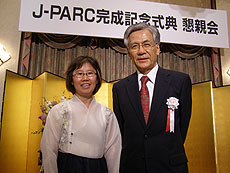 There is a new star in the particle physics firmament. With great fanfare and some thousand celebrants, the inauguration of the Japan Proton Accelerator Research Complex (J-PARC) took place in Tokyo on Monday. Ministers, Diet members, mayors, politicians, Nobel Prize winners, laboratory directors, physicists, the press and many visitors from abroad were on hand to hear presentations on the physics and history of J-PARC and to congratulate Shoji Nagamiya the director of J-PARC and his colleagues on the completion of this great facility. Fermilab Deputy Director Young-Kee Kim represented our laboratory at the celebrations.
There is a new star in the particle physics firmament. With great fanfare and some thousand celebrants, the inauguration of the Japan Proton Accelerator Research Complex (J-PARC) took place in Tokyo on Monday. Ministers, Diet members, mayors, politicians, Nobel Prize winners, laboratory directors, physicists, the press and many visitors from abroad were on hand to hear presentations on the physics and history of J-PARC and to congratulate Shoji Nagamiya the director of J-PARC and his colleagues on the completion of this great facility. Fermilab Deputy Director Young-Kee Kim represented our laboratory at the celebrations.
|
| June 30, 2009 |
| Protective equipment |
|
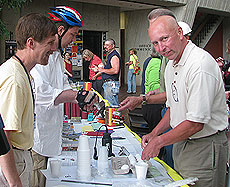 The importance of using protective equipment when carrying out hazardous tasks cannot be overemphasized. Yesterday, during lunch time, we had an ES&H fair where we had the opportunity to meet our senior safety officers, our firefighters and emergency personnel and the chance to inspect protective gear at several tables. Safety gear needs to be well designed, but also must be worn! After the fair I received the following e-mail message from Traffic Safety Subcommittee member David Peterson, which I reproduce below to encourage you to always wear a helmet when you ride and use the appropriate protective equipment for any task you perform. Safety equipment can save your life.
The importance of using protective equipment when carrying out hazardous tasks cannot be overemphasized. Yesterday, during lunch time, we had an ES&H fair where we had the opportunity to meet our senior safety officers, our firefighters and emergency personnel and the chance to inspect protective gear at several tables. Safety gear needs to be well designed, but also must be worn! After the fair I received the following e-mail message from Traffic Safety Subcommittee member David Peterson, which I reproduce below to encourage you to always wear a helmet when you ride and use the appropriate protective equipment for any task you perform. Safety equipment can save your life.
|
| June 23, 2009 |
| Yearly retreat |
|
 It has been a tradition over several decades at Fermilab to have an extended retreat in June with our Program Advisory Committee.The retreat brings together the outstanding members of the national and international community that form the PAC together with the leadership of the laboratory. DOE and NSF participate by sending observers to the meeting. We review critically the roadmap for the laboratory and the new ideas that we receive for projects that may be incorporated into that roadmap in the future.
It has been a tradition over several decades at Fermilab to have an extended retreat in June with our Program Advisory Committee.The retreat brings together the outstanding members of the national and international community that form the PAC together with the leadership of the laboratory. DOE and NSF participate by sending observers to the meeting. We review critically the roadmap for the laboratory and the new ideas that we receive for projects that may be incorporated into that roadmap in the future.
With prior input from the PAC, the basic roadmap of the laboratory will evolve along three frontiers, energy, intensity and cosmic, with well-defined plans and outstanding projects in each. That is consistent with the P5 advice to the agencies and has been well received in Congress. The main uncertainties associated with this roadmap arise primarily from two inputs: physics discoveries and funding.
|
| June 16, 2009 |
| Neutrinos |
|
 Neutrinos play a central role in the future Fermilab program. Last week Young-Kee Kim, Boris Kayser, Stephen Parke and I had the opportunity to brief the leadership of the Office of Science, including the next director of the Office of Science, Bill Brinkman, on the physics of neutrinos and on the long-term plans for the study of neutrinos in the world and at Fermilab. While we have great expectations for the discovery of physics beyond the Standard Model at the LHC, every bit of physics we expect to discover beyond the Standard Model is speculative at this time. The discovery of neutrino mass, on the other hand, has already given us evidence for physics beyond the Standard Model and a window into the study of that physics.
Neutrinos play a central role in the future Fermilab program. Last week Young-Kee Kim, Boris Kayser, Stephen Parke and I had the opportunity to brief the leadership of the Office of Science, including the next director of the Office of Science, Bill Brinkman, on the physics of neutrinos and on the long-term plans for the study of neutrinos in the world and at Fermilab. While we have great expectations for the discovery of physics beyond the Standard Model at the LHC, every bit of physics we expect to discover beyond the Standard Model is speculative at this time. The discovery of neutrino mass, on the other hand, has already given us evidence for physics beyond the Standard Model and a window into the study of that physics.
Steve Weinberg has called the discovery of neutrino mass the most important discovery in particle physics in the last quarter century. There are a billion times more neutrinos in the universe than there are fermions. As light as they are, perhaps a million times lighter than electrons, neutrinos’ total mass adds up to the mass of all the stars. They have affected the evolution of the universe, permeating all space, yet of all the particles we have discovered in nature, they are the least understood.
|
| June 9, 2009 |
| Goal Zero: Safe and Healthy |
|
 When we talk about safety performance at Fermilab, we talk about the number of incidents as a way of measuring our performance. While it is a way to measure, it is odd to claim we had a good performance because we “only” had a given number of injuries. The only number that makes sense when it comes to injuries is zero. Goal Zero means staying healthy and avoiding injuries. Recently we have moved further from zero than in past years.
When we talk about safety performance at Fermilab, we talk about the number of incidents as a way of measuring our performance. While it is a way to measure, it is odd to claim we had a good performance because we “only” had a given number of injuries. The only number that makes sense when it comes to injuries is zero. Goal Zero means staying healthy and avoiding injuries. Recently we have moved further from zero than in past years.
To help us achieve Goal Zero, I am launching a new campaign called “Take Five.” It is a method that has proved useful at other institutions and can be of help here at Fermilab. Take Five is a reminder to take your time. Take five minutes before a job to consider how to do it safely; take five seconds to think about what you’re going to do before you do it; take five things to reflect on after the job is done. This simple exercise will help all of us avoid the issues that arise when we act too quickly. It also serves as a mechanism for our talented technical staff to provide feedback into work processes and make them better.
|
| June 2, 2009 |
| Global vision |
|
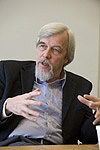 Globalization is part of the early 21st century zeitgeist, but for particle physics it’s nothing new. Our field has always worked globally. When CERN was established in the 1950s, Fermilab did not yet exist. Brookhaven was CERN’s natural American partner and competitor. Competition was fierce, though not in the traditional sense of the word. Then as now, our objectives were shared and although each lab wanted to be first, the overriding goal was generating knowledge and innovation for the common good. Back then, when Brookhaven scientists developed the technique of strong focussing, their instinct was to share it with CERN. The result was that our 10 GeV proton synchrotron became a 25 GeV machine that started up 50 years ago, and Brookhaven even helped us commission it. Today’s equivalent is manifest in the unprecedented level of support that CERN is receiving from other labs, notably Fermilab, in preparing the LHC for a restart later this year. Yes we’re in competition, but it’s a healthy competition that benefits us all – regardless of where the discoveries and technological advances are made.
Globalization is part of the early 21st century zeitgeist, but for particle physics it’s nothing new. Our field has always worked globally. When CERN was established in the 1950s, Fermilab did not yet exist. Brookhaven was CERN’s natural American partner and competitor. Competition was fierce, though not in the traditional sense of the word. Then as now, our objectives were shared and although each lab wanted to be first, the overriding goal was generating knowledge and innovation for the common good. Back then, when Brookhaven scientists developed the technique of strong focussing, their instinct was to share it with CERN. The result was that our 10 GeV proton synchrotron became a 25 GeV machine that started up 50 years ago, and Brookhaven even helped us commission it. Today’s equivalent is manifest in the unprecedented level of support that CERN is receiving from other labs, notably Fermilab, in preparing the LHC for a restart later this year. Yes we’re in competition, but it’s a healthy competition that benefits us all – regardless of where the discoveries and technological advances are made.
|
| May 26, 2009 |
| Tune IT up |
|
 A Department of Energy cybersecurity audit last week found very serious shortcomings in how we are managing our computers at Fermilab. Among other problems, the review team found unlocked doors leading to open computers on employees’ desks, easy access to system administrators’ accounts, passwords openly displayed and failure to respond quickly to virus alerts. Overall, we received a cybersecurity grade of “marginal.”
A Department of Energy cybersecurity audit last week found very serious shortcomings in how we are managing our computers at Fermilab. Among other problems, the review team found unlocked doors leading to open computers on employees’ desks, easy access to system administrators’ accounts, passwords openly displayed and failure to respond quickly to virus alerts. Overall, we received a cybersecurity grade of “marginal.”
The world-class science at our laboratory requires world-class management of our computing resources. Moreover, we must do this within the context of the cybersecurity requirements of the federal government, including DOE, which provides those resources. As the audit showed us, addressing these findings will require a culture change at Fermilab. At a laboratory where we value creative thinking and individual points of view, we are accustomed to great personal latitude in the way we manage our computers. The realities of today’s cybersecurity environment mean that we will have to give up some of that individual latitude for the sake of the safety and efficiency of scientific operations.
|
| May 19, 2009 |
| Focus Group Report |
|
 From November 2008 through January 2009, 23 focus groups gave a cross-section of Fermilab employees and users the opportunity to provide an in-depth look at the work environment at the laboratory. When we began this process, I committed to make public the results of the focus groups and the accompanying report. I hope you will take time to read and think about them. For anyone who cares about Fermilab, they make compelling reading.
From November 2008 through January 2009, 23 focus groups gave a cross-section of Fermilab employees and users the opportunity to provide an in-depth look at the work environment at the laboratory. When we began this process, I committed to make public the results of the focus groups and the accompanying report. I hope you will take time to read and think about them. For anyone who cares about Fermilab, they make compelling reading.
A primary purpose of the focus groups was to examine workplace issues for women and members of minorities, but they also explored a wide range of issues affecting the working environment. To protect the privacy of the participants and encourage candid dialog, Fermilab engaged a consultant, The Perspectives Group, to design and carry out the focus-group process using a representative sample of the full range of Fermilab employees and users. All in all, 187 employees and users took part.
|
| May 12, 2009 |
| Interdependence |
|
 At Fermilab we have a strong tradition of serving the university community. Fermilab’s start in the’60s, in competition with other institutions that aimed to build the largest accelerator in the world, was anchored in the idea of creating a truly national laboratory, one that would serve all institutions equally—where users would be “at home and loved,” as Leon lederman said at the time. The contractor selected for this new laboratory was URA, an organization that embodied these principles. The tradition of service is also a part of our scientific staff. Our scientists not only carry out research, but tackle many of the supporting roles necessary to make experiments and accelerators work.
At Fermilab we have a strong tradition of serving the university community. Fermilab’s start in the’60s, in competition with other institutions that aimed to build the largest accelerator in the world, was anchored in the idea of creating a truly national laboratory, one that would serve all institutions equally—where users would be “at home and loved,” as Leon lederman said at the time. The contractor selected for this new laboratory was URA, an organization that embodied these principles. The tradition of service is also a part of our scientific staff. Our scientists not only carry out research, but tackle many of the supporting roles necessary to make experiments and accelerators work.
|
| May 5, 2009 |
| A consequential week |
|
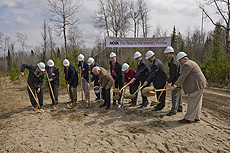 Last week was a multistate journey, highlighted by the groundbreaking for the NOvA building in Minnesota on Friday, made possible by the American Recovery and Reinvestment Act funding. It is the first ground breaking for a major particle physics project in more than a decade. We hope it is the first of several during the next few years. The ceremony, with eloquent speeches by officials of the University of Minnesota, the Department of Energy, the NOvA experiment and Fermilab, and Minnesota Congressman James Oberstar and Illinois Congressman Bill Foster, was follow by enthusiastic digging with many shovels. It has taken the efforts of many to get to this important milestone. The project will enhance the nation’s role in the world of physics and benefit immediately the surrounding communities in Minnesota and Illinois.
Last week was a multistate journey, highlighted by the groundbreaking for the NOvA building in Minnesota on Friday, made possible by the American Recovery and Reinvestment Act funding. It is the first ground breaking for a major particle physics project in more than a decade. We hope it is the first of several during the next few years. The ceremony, with eloquent speeches by officials of the University of Minnesota, the Department of Energy, the NOvA experiment and Fermilab, and Minnesota Congressman James Oberstar and Illinois Congressman Bill Foster, was follow by enthusiastic digging with many shovels. It has taken the efforts of many to get to this important milestone. The project will enhance the nation’s role in the world of physics and benefit immediately the surrounding communities in Minnesota and Illinois.
|
| Apr. 28, 2009 |
| Celebration! |
|
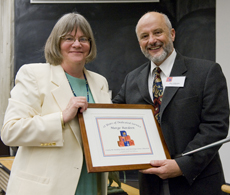 Last Friday night we celebrated Marjorie Bardeen and her 25 years of dedicated and creative service to Fermilab Friends for Science Education. Marge stepped down last year from leading FFSE, the not-for-profit membership organization that contributes to education programs at the laboratory. Susan Dahl has assumed the leadership of FFSE and Marge continues to lead our Education Office.
Last Friday night we celebrated Marjorie Bardeen and her 25 years of dedicated and creative service to Fermilab Friends for Science Education. Marge stepped down last year from leading FFSE, the not-for-profit membership organization that contributes to education programs at the laboratory. Susan Dahl has assumed the leadership of FFSE and Marge continues to lead our Education Office.
Friday night’s event was a celebration not only of Marge, but also of the great education program that exists today at Fermilab under Marge’s leadership. Membership fees and individual and corporate contributions through FFSE give us flexibility to design new programs and to enhance the education programs that we can carry out with DOE and NSF support. In 1983, FFSE, then called Friends of Fermilab, offered the first professional development program for teachers, the Summer Institute for Science Teachers. This pioneering adventure set a key characteristic for all the programs that followed: the involvement of teachers at an early stage. Since then, every program first listens to what the teachers and administrators need for their students’ science education.
|
| Apr. 21, 2009 |
| EVMS |
|
 Earned Value Management (EVM) is a methodology for integrating scope, schedule and resources to measure the performance and progress of projects against an agreed-to baseline plan. The system that is put in place to implement this methodology is EVMS.
Earned Value Management (EVM) is a methodology for integrating scope, schedule and resources to measure the performance and progress of projects against an agreed-to baseline plan. The system that is put in place to implement this methodology is EVMS.
Earned Value concepts started in the 60s during the development of large projects. The basis for these concepts is very simple: how much value have we created with what effort, and do these match our plan at a given stage? Implementing an accurate measurement system, however, is not simple. At Fermilab we have applied these concepts for a number of years to our projects, but not to their full extent and power. EVMS is now considered best practice and is the standard adopted by the federal government and the project management industry. To carry out large projects in the future, FRA needs to be certified as meeting the ANSI/EIA-748-B Earned Value Management Systems standard.
|
| Apr. 14, 2009 |
| A week of reviews |
|
 Last week two very important review committees came to the laboratory. Their respective meetings spanned the full week. Steve Holmes, who played important roles in both reviews, spent five solid days in the Comitium!
Last week two very important review committees came to the laboratory. Their respective meetings spanned the full week. Steve Holmes, who played important roles in both reviews, spent five solid days in the Comitium!
The first review was by the Muon Technical Advisory Committee (MUTAC), chaired by David Rubin of Cornell University. The committee reports to the laboratory directors of Fermilab, Brookhaven National Laboratory and Lawrence Berkeley National Laboratory on the progress and plans for a multi-TeV muon collider as developed by the The Neutrino Factory and Muon Collider Collaboration (NFMCC) and the Muon Collider Task Force (MCTF). While there is general agreement that discoveries at the LHC will require the development of a lepton collider, we will not know the energy of such a collider until we learn new physics from the LHC. By far, the most straightforward collider to follow the LHC discoveries would be the ILC, provided most of the important physics lies below one TeV. If the LHC shows us that substantial physics lies above one TeV, we will need an affordable new technology for a multi-TeV lepton collider. This will take time to develop.
|
| Apr. 7, 2009 |
| Concern and sympathy |
|
 A devastating earthquake has struck the region of the Abruzzi in Italy, centered around the town of l’Aquila. This is the location of the Gran Sasso Laboratory, the University of l’Aquila, and the place where collaborators, colleagues and friends reside and work. Many buildings built of stone have collapsed in the center of l’Aquila, a beautiful ancient town near Gran Sasso. Similar destruction has rained on the surrounding villages. Our concerns and prayers are with the families of those affected in this region. Tens of thousands have been left homeless and more than 200 people are known dead with others trapped in collapsed buildings. While we have heard from several colleagues that they are safe and that the laboratory seems to have survived without much damage, it is early in the assessment and the full extent will only be known in several days.
A devastating earthquake has struck the region of the Abruzzi in Italy, centered around the town of l’Aquila. This is the location of the Gran Sasso Laboratory, the University of l’Aquila, and the place where collaborators, colleagues and friends reside and work. Many buildings built of stone have collapsed in the center of l’Aquila, a beautiful ancient town near Gran Sasso. Similar destruction has rained on the surrounding villages. Our concerns and prayers are with the families of those affected in this region. Tens of thousands have been left homeless and more than 200 people are known dead with others trapped in collapsed buildings. While we have heard from several colleagues that they are safe and that the laboratory seems to have survived without much damage, it is early in the assessment and the full extent will only be known in several days.
|
| Mar. 31, 2009 |
| Deep down |
|
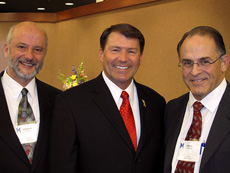 Last Thursday, groups from DOE, NSF, Fermilab, Brookhaven National Laboratory and Lawrence Berkeley National Laboratory visited the Homestake mine, the site selected by NSF for the proposed Deep Underground Science and Engineering Laboratory (DUSEL). Currently Homestake is the site of the Sanford Underground Laboratory, funded jointly by the State of South Dakota and a private donation by Denny Sanford, a prominent citizen of South Dakota.
Last Thursday, groups from DOE, NSF, Fermilab, Brookhaven National Laboratory and Lawrence Berkeley National Laboratory visited the Homestake mine, the site selected by NSF for the proposed Deep Underground Science and Engineering Laboratory (DUSEL). Currently Homestake is the site of the Sanford Underground Laboratory, funded jointly by the State of South Dakota and a private donation by Denny Sanford, a prominent citizen of South Dakota.
Homestake is a legendary site for particle physics, the location of the “Davis” cavern where Ray Davis carried out his ground-breaking experiment starting in the 1960s to detect neutrinos from the Sun. His results were the first indication that neutrinos were not behaving as expected. This behavior was finally elucidated by the Super Kamiokande experiment in Japan, which Masatoshi Koshiba worked on. Davis and Koshiba shared the Physics Nobel Prize in 2002 for the detection of cosmic neutrinos. (The physics prize that year was also shared by Riccardo Giacconi for the discovery of x-ray sources).
|
| Mar. 24, 2009 |
| Fermilab and the Recovery Act |
|
 Yesterday in a speech at Brookhaven, Secretary Steve Chu announced the first release of funds by the Office of Science under the American Recovery and Reinvestment Act. As Secretary Chu said in DOE's press release, these funds will be used to invest in our nation's long-term future and to provide vital short-term economic relief. At Fermilab, we will be using the Recovery Act funds we receive to do exactly that. We plan to invest $25 million in critically needed GPP projects at the laboratory and $9.9 million in purchasing high-tech components for NOvA, the next big scientific project on Fermilab's horizon.
Yesterday in a speech at Brookhaven, Secretary Steve Chu announced the first release of funds by the Office of Science under the American Recovery and Reinvestment Act. As Secretary Chu said in DOE's press release, these funds will be used to invest in our nation's long-term future and to provide vital short-term economic relief. At Fermilab, we will be using the Recovery Act funds we receive to do exactly that. We plan to invest $25 million in critically needed GPP projects at the laboratory and $9.9 million in purchasing high-tech components for NOvA, the next big scientific project on Fermilab's horizon.
These projects will create immediate jobs in the economy external to Fermilab—here in Illinois, in Minnesota and at engineering and manufacturing companies around the nation. They will also make Fermilab more competitive in its future scientific programs and allow us to operate with higher efficiency and reliability. These are one-time funds aimed at stimulating the economy; we will not use them to enlarge our own laboratory staff.
|
| Mar. 11, 2009 |
| Padova |
|
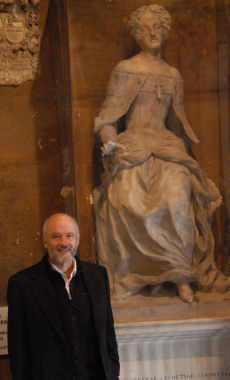 Yesterday I visited the University of Padova to discuss potential future collaborations with the leadership of the Istituto Nazionale di Fisica Nucleare (INFN). Professor Roberto Petronzio, President of INFN, and his colleagues were very welcoming. Fermilab has had a hugely valuable collaboration with Italian groups supported by INFN over many years. We both are interested now in extending our collaboration to future projects. An area where we have a commonality of interests and where we could develop an important collaboration is in the development of liquid argon time projection chambers for the study of neutrino interactions.
Yesterday I visited the University of Padova to discuss potential future collaborations with the leadership of the Istituto Nazionale di Fisica Nucleare (INFN). Professor Roberto Petronzio, President of INFN, and his colleagues were very welcoming. Fermilab has had a hugely valuable collaboration with Italian groups supported by INFN over many years. We both are interested now in extending our collaboration to future projects. An area where we have a commonality of interests and where we could develop an important collaboration is in the development of liquid argon time projection chambers for the study of neutrino interactions.
Italian groups under the direction of Carlo Rubbia have pioneered liquid argon TPCs and are ready to fill a 600-ton detector, ICARUS, deep underground in the Gran Sasso laboratory. Later this year they should be in a position to detect neutrinos from the CERN beam. In addition, they are proposing to build multi-kiloton liquid argon detectors for future long base line experiments. At Fermilab we have an R&D program towards the development of the technology. We are ready to use a small detector, ArgoNeut, in the NUMI hall; we are developing MicroBooNE to determine the nature of the excess events at low energies observed by MiniBooNE and at the same time learn how to scale detectors to large masses; and, we will be designing very large multi-kiloton detectors for future long-baseline neutrino experiments such as DUSEL. Clearly there is much to gain in moving forward in collaboration. Several models are possible, and we will explore them over the next several months.
|
| Mar. 3, 2009 |
| Washington week in review |
|
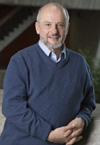 Monday through Thursday was a busy week for us in Washington, D.C. On Monday I made visits to congressional offices and the Office of Management and Budget. That evening, I attended a dinner with fellow laboratory directors to thank Ray Orbach and Jack Marburger for their many years of devoted service to the scientific community during the previous administration. DOE Secretary Steve Chu graciously dropped by the dinner to add his thanks to Ray and Jack. The HEPAP meeting took place Tuesday and Wednesday with many detailed presentations about DOE and NSF programs and an opening address by Office of Science acting director Pat Dehmer. Most importantly for us she described Secretary Chu’s priorities, in which basic science has a prominent position. On Wednesday the executive committee of the National Director’s Council (San Aronson, Thom Mason, Tom Hunter and myself) had an extended meeting with Secretary Chu. On Thursday, senior laboratory managers made a full-day-full-detail budget presentation to all the managers of the DOE Office of High Energy Physics.
Monday through Thursday was a busy week for us in Washington, D.C. On Monday I made visits to congressional offices and the Office of Management and Budget. That evening, I attended a dinner with fellow laboratory directors to thank Ray Orbach and Jack Marburger for their many years of devoted service to the scientific community during the previous administration. DOE Secretary Steve Chu graciously dropped by the dinner to add his thanks to Ray and Jack. The HEPAP meeting took place Tuesday and Wednesday with many detailed presentations about DOE and NSF programs and an opening address by Office of Science acting director Pat Dehmer. Most importantly for us she described Secretary Chu’s priorities, in which basic science has a prominent position. On Wednesday the executive committee of the National Director’s Council (San Aronson, Thom Mason, Tom Hunter and myself) had an extended meeting with Secretary Chu. On Thursday, senior laboratory managers made a full-day-full-detail budget presentation to all the managers of the DOE Office of High Energy Physics.
|
| Feb. 24, 2009 |
| A matter of concern |
|
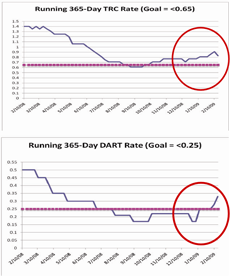 We are very proud of the safety culture at Fermilab. At all levels of the organization we perform our work safely and we care about the safety of our co-workers. We constantly look for opportunities to improve our work environment and our procedures. It is important, however, not only to understand every injury to determine the underlying causes, but to measure our performance and raise our attention when our performance appears to be going south.
We are very proud of the safety culture at Fermilab. At all levels of the organization we perform our work safely and we care about the safety of our co-workers. We constantly look for opportunities to improve our work environment and our procedures. It is important, however, not only to understand every injury to determine the underlying causes, but to measure our performance and raise our attention when our performance appears to be going south.
The chart included with this column shows the rolling average in total recordable cases (TRC) and injuries requiring days away or restrictions (DART) for the last 365 days. It shows the extraordinary improvement we achieved last year bringing down our TRC and DART rates by a significant factor. We met all targets and this performance was recognized and commented on by the Department of Energy. Recently, however, we have seen an uptick in the rates, which is a matter of concern. In the first five months of the year, we already have two more DART cases than last year and we are already above our target for the entire fiscal year 2009.
|
| Feb. 17, 2009 |
| Recovery |
|
 For us, passage of the American Recovery and Reinvestment Act was the big news of the week, the year and--barring discovery of the Higgs--the decade. It makes a large investment in science and technology to support not only the creation of jobs but the nation’s competitiveness. The investment in the DOE Office of Science contained in the act is $1.6 billion. Overall the act invests significantly in all the science agencies and in education.
For us, passage of the American Recovery and Reinvestment Act was the big news of the week, the year and--barring discovery of the Higgs--the decade. It makes a large investment in science and technology to support not only the creation of jobs but the nation’s competitiveness. The investment in the DOE Office of Science contained in the act is $1.6 billion. Overall the act invests significantly in all the science agencies and in education.
While the specifics are still being worked out by DOE and the Office of Management and Budget, we hope for major advances here at Fermilab: funding to accelerate NOvA; to build the infrastructure for developing, prototyping, testing and industrializing superconducting accelerator components; and for the immediate construction of four general plant projects. The “GPP” projects include the upgrade of Feynman to support needed computational engines, the extension of the New Muon Laboratory to allow the full tests of three cryomodules, the development of the space necessary for the handling of neutrino beam radioactive components in MI-8, and the extension of our industrial building IB-3. By moving rapidly and responsibly to put these funds to work, we will maximize their impact on the economic recovery of our region, including creating jobs largely outside the laboratory. These funds will not only create jobs immediately but will also increase Fermilab’s capabilities and efficiency in carrying out our future scientific programs. At the same time we will increase the nation’s industrial capabilities to build future accelerator projects.
|
| Feb. 11, 2009 |
| India Collaboration |
|
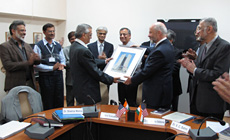 Yesterday I had the honor to give the opening lecture at the 2009 Indian Particle Accelerator Conference. I was in Indore at the Raja Ramana Center for Advanced Technology, one of India’s large national laboratories, to sign a memorandum of understanding with four Indian laboratories enlarging our collaboration on superconducting RF accelerators. Some 150 accelerator physicists from across India were in attendance. After my lecture, I was also honored to spend the day with the Secretary of the Department of Atomic Energy Agency, Dr. Anil Kakodkar, and the director of RRCAT, Dr. Vinod Sahni. We discussed the development of accelerators in the U.S. and in India, the neutrino programs including the large underground Indian Neutrino Observatory, the development of particle physics in the world, the education of the next generation of scientists, the impact that Indian collaborations with Fermilab have had over the years and our hope for future collaboration on Project X and global machines such as the ILC.
Yesterday I had the honor to give the opening lecture at the 2009 Indian Particle Accelerator Conference. I was in Indore at the Raja Ramana Center for Advanced Technology, one of India’s large national laboratories, to sign a memorandum of understanding with four Indian laboratories enlarging our collaboration on superconducting RF accelerators. Some 150 accelerator physicists from across India were in attendance. After my lecture, I was also honored to spend the day with the Secretary of the Department of Atomic Energy Agency, Dr. Anil Kakodkar, and the director of RRCAT, Dr. Vinod Sahni. We discussed the development of accelerators in the U.S. and in India, the neutrino programs including the large underground Indian Neutrino Observatory, the development of particle physics in the world, the education of the next generation of scientists, the impact that Indian collaborations with Fermilab have had over the years and our hope for future collaboration on Project X and global machines such as the ILC.
|
| Feb. 3, 2009 |
| Chicagoland collaboration |
|
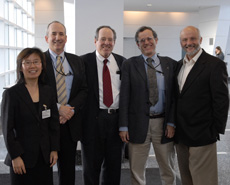 Yesterday afternoon we had the fifth collaboration meeting bringing together scientists and program leaders from Argonne National Laboratory, Fermilab and the University of Chicago. Over the last two years we have seeded several collaborative activities, in both the scientific and operational domains, that are now well established.
Yesterday afternoon we had the fifth collaboration meeting bringing together scientists and program leaders from Argonne National Laboratory, Fermilab and the University of Chicago. Over the last two years we have seeded several collaborative activities, in both the scientific and operational domains, that are now well established.
It was time to take stock of the progress in these collaborations. Both laboratory directors, the university vice president for research and national labs and the university dean for physical sciences attended the meeting along with some 80 scientists. The meeting started with the deputy directors presenting both the Fermilab and ANL strategic plans.
|
| Jan. 27, 2009 |
| IQA |
|
 Here is a new acronym to learn: IQA, for Integrated Quality Assurance. It parallels the name Integrated Safety Management, the systematic approach we use in managing safety. Now we want to take the same approach to QA: to integrate it into the way that we carry out our work, systematically building it from the beginning into all our activities. Like ISM, IQA is a line management responsibility at all levels of the organization. Of course, we already know we do great, high quality work. So why do we need a new approach?
Here is a new acronym to learn: IQA, for Integrated Quality Assurance. It parallels the name Integrated Safety Management, the systematic approach we use in managing safety. Now we want to take the same approach to QA: to integrate it into the way that we carry out our work, systematically building it from the beginning into all our activities. Like ISM, IQA is a line management responsibility at all levels of the organization. Of course, we already know we do great, high quality work. So why do we need a new approach?
Many examples illustrate where a systematic approach to QA activities could have helped us deliver a better product or avoid problems. We do not have to look far to find spectacular examples of problems that arose from failures of QA in design or fabrication. Think of our own LHC triplets or CERN’s faulty bus-bar splice that will cause nine months’ delay in the turn-on of the machine. Furthermore, a systematic approach to QA is a foundation of trying to continuously improve our processes.
|
| Jan. 21, 2009 |
| A physicist at the inauguration |
|
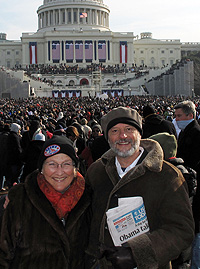 Together with perhaps two million people, Barbara and I had the good fortune to be at the inauguration of President Barack Obama. The feeling of sharing a celebration with more than a million others, a rainbow of people from every walk of life and every background, united in the hope for a better tomorrow, was a moment to capture hearts and fire imaginations. Many families with members of three generations, with tears in the eyes of the elders and smiles in the faces of the young, gave their youngest the unforgettable experiences to shape their life's feelings about civic life, democracy and our government.
Together with perhaps two million people, Barbara and I had the good fortune to be at the inauguration of President Barack Obama. The feeling of sharing a celebration with more than a million others, a rainbow of people from every walk of life and every background, united in the hope for a better tomorrow, was a moment to capture hearts and fire imaginations. Many families with members of three generations, with tears in the eyes of the elders and smiles in the faces of the young, gave their youngest the unforgettable experiences to shape their life's feelings about civic life, democracy and our government.
In a multitude such as yesterday's and with long waits, a physicist's mind wanders. First, as the crush of people funnels for hours through the security choke points, individuals no longer the masters of their own directions but rather part of fluid flow, the mind calculates whether there is enough time for this fluid to make it through the gates before the President's address. After an hour in the frigid weather, the mind wonders what the equilibrium temperature of ones toes might be after five more hours. Eventually the mind gets to a higher plane. How many different hopes do a million people in the mall and the many million more throughout the country carry with them and how in the world will they be accommodated when the "hard choices" have to be made?
|
| Jan. 6, 2009 |
| Resolutions |
|
 The new year brings about new resolve. It is customary to make resolutions that promise to bring about improvements in how we live our lives. These resolutions are easy to make and often quite difficult to keep. It is a good thing that the score keeping is pretty sloppy.
The new year brings about new resolve. It is customary to make resolutions that promise to bring about improvements in how we live our lives. These resolutions are easy to make and often quite difficult to keep. It is a good thing that the score keeping is pretty sloppy.
In this atmosphere of increased resolve brought by the new year, it is useful to think of all that we want to accomplish at Fermilab in 2009. For us, it is a more serious affair since a lot of planning goes into setting our goals for 2009; they are public and the DOE will surely keep score.
|
Director's Corner - Current Archive
2014 Director's Corner Archive
2013 Director's Corner Archive
2012 Director's Corner Archive
2011 Director's Corner Archive
2010 Director's Corner Archive
2009 Director's Corner Archive
Return to Current Fermilab Today
|
 During the last two weeks I visited Perú for the first time in more than 20 years. I found a country much changed and developing quickly. I grew up in Perú and left in 1960 to study in the US at a time when it would have been nearly impossible to study physics in Perú. While Perú has a long way to go in physics, the drive to understand and promote science generally is there, thanks to the heroic effort of a few devoted academics over the last decades. In high energy physics both the Pontificia Universidad Católica del Peru (PUCP) and the Universidad Nacional de Ingeniería (UNI) have groups working at Fermilab in the Minerva collaboration. My visit was an opportunity for building new relations and promoting the importance of science and technology.
During the last two weeks I visited Perú for the first time in more than 20 years. I found a country much changed and developing quickly. I grew up in Perú and left in 1960 to study in the US at a time when it would have been nearly impossible to study physics in Perú. While Perú has a long way to go in physics, the drive to understand and promote science generally is there, thanks to the heroic effort of a few devoted academics over the last decades. In high energy physics both the Pontificia Universidad Católica del Peru (PUCP) and the Universidad Nacional de Ingeniería (UNI) have groups working at Fermilab in the Minerva collaboration. My visit was an opportunity for building new relations and promoting the importance of science and technology.  The last couple of weeks we have had some notable events, first among them the smooth turn-on of the LHC. Detectors are now collecting data at 0.9 TeV center-of-mass energy, a very important step in bringing the detectors and the machine to full performance. Both beams were brought to a record energy of 1.18 TeV per beam about a week ago, making the LHC the highest-energy collider in the world. There is clearly much yet to do to reach the full potential of the LHC, but these first steps augur well for the future. Congratulations to our colleagues at the LHC and to those at Fermilab who have worked so hard to get the accelerator and the CMS experiment ready for data.
The last couple of weeks we have had some notable events, first among them the smooth turn-on of the LHC. Detectors are now collecting data at 0.9 TeV center-of-mass energy, a very important step in bringing the detectors and the machine to full performance. Both beams were brought to a record energy of 1.18 TeV per beam about a week ago, making the LHC the highest-energy collider in the world. There is clearly much yet to do to reach the full potential of the LHC, but these first steps augur well for the future. Congratulations to our colleagues at the LHC and to those at Fermilab who have worked so hard to get the accelerator and the CMS experiment ready for data. Last week activities at Fermilab were at a peak. Not only was the experimental program in full swing, but we had two important workshops, one on the experimental program of Project X and the other on the experimental reach of a possible muon collider. To top it all we had the fall meeting of the Program Advisory Committee with one of its busiest agendas ever.
Last week activities at Fermilab were at a peak. Not only was the experimental program in full swing, but we had two important workshops, one on the experimental program of Project X and the other on the experimental reach of a possible muon collider. To top it all we had the fall meeting of the Program Advisory Committee with one of its busiest agendas ever.  Between the colloquium at Johns Hopkins last Thursday and a presentation to the URA Board of Trustees yesterday back in Washington, D.C., I made a quick trip to Irvine, Calif., to make a presentation to the National Academy of Science's Board on Physics and Astronomy. My presentation was on the Fermilab program. It was part of an analysis by the BPA on the results of EPP2010, the broad NAS committee that made recommendations for the development of particle physics in the U.S. While it seems yesterday that we were dealing with EPP2010 — and 2010 was a few years away — now 2010 is around the corner. EPP 2010 was quite different from other NAS committee in that it included notable individuals outside our field. It was charged to prioritize opportunities and develop recommendations for the next 15 years. Dennis Kovar, head of the Office of High Energy Physics in DOE, Mel Shochet, chair of HEPAP, and Barry Barish among others, also made presentations to the BPA at Irvine.
Between the colloquium at Johns Hopkins last Thursday and a presentation to the URA Board of Trustees yesterday back in Washington, D.C., I made a quick trip to Irvine, Calif., to make a presentation to the National Academy of Science's Board on Physics and Astronomy. My presentation was on the Fermilab program. It was part of an analysis by the BPA on the results of EPP2010, the broad NAS committee that made recommendations for the development of particle physics in the U.S. While it seems yesterday that we were dealing with EPP2010 — and 2010 was a few years away — now 2010 is around the corner. EPP 2010 was quite different from other NAS committee in that it included notable individuals outside our field. It was charged to prioritize opportunities and develop recommendations for the next 15 years. Dennis Kovar, head of the Office of High Energy Physics in DOE, Mel Shochet, chair of HEPAP, and Barry Barish among others, also made presentations to the BPA at Irvine.  The International Workshop on Next Generation Nucleon Decay and Neutrino Detectors, NNN09, took place in Estes Park, Colorado, Oct. 8-10. This was the tenth in a series of meetings that have taken place annually around the world, focusing on experiments that go beyond the reach of current projects and the theoretical work that motivates and describes such advances. An additional purpose of these meetings is to build international collaborations. The meeting had strong participation from the U.S., Japan and Europe. I gave the closing talk at the conference.
The International Workshop on Next Generation Nucleon Decay and Neutrino Detectors, NNN09, took place in Estes Park, Colorado, Oct. 8-10. This was the tenth in a series of meetings that have taken place annually around the world, focusing on experiments that go beyond the reach of current projects and the theoretical work that motivates and describes such advances. An additional purpose of these meetings is to build international collaborations. The meeting had strong participation from the U.S., Japan and Europe. I gave the closing talk at the conference. Last week was a busy week for me in Washington, DC. I visited DOE officials in the Office of Science on Tuesday and attended the unveiling of the official portrait of Secretary Bodman. All the official portraits of past secretaries hang together in the corridor outside the DOE Secretary's Office. On Wednesday I visited several Congressional offices and the Office of Management and Budget. Finally, on Thursday, I was a witness along with Dennis Kovar, Harvard physicist Lisa Randall and Jefferson Laboratory Director Hugh Montgomery in front of the Energy and Environment Subcommittee of the House Science and Technology Committee. Two of the Illinois members of the Subcommittee were present: Representative Daniel Lipinski, who presided over the committee for part of the hearing, and Representative Judy Biggert, both great friends of science and Fermilab. You can find the written testimony and, eventually, the Web cast here.
Last week was a busy week for me in Washington, DC. I visited DOE officials in the Office of Science on Tuesday and attended the unveiling of the official portrait of Secretary Bodman. All the official portraits of past secretaries hang together in the corridor outside the DOE Secretary's Office. On Wednesday I visited several Congressional offices and the Office of Management and Budget. Finally, on Thursday, I was a witness along with Dennis Kovar, Harvard physicist Lisa Randall and Jefferson Laboratory Director Hugh Montgomery in front of the Energy and Environment Subcommittee of the House Science and Technology Committee. Two of the Illinois members of the Subcommittee were present: Representative Daniel Lipinski, who presided over the committee for part of the hearing, and Representative Judy Biggert, both great friends of science and Fermilab. You can find the written testimony and, eventually, the Web cast here.
 Last Monday and Tuesday we hosted nine program managers from DOE's Office of High Energy Physics. This was not one of our "normal" reviews in which judgments are drawn on how we are performing against goals set by OHEP. This was an informal visit for both the program managers in OHEP and our own managers to get to know each other and to become familiar with the issues we confront in managing a complex enterprise like Fermilab.
Last Monday and Tuesday we hosted nine program managers from DOE's Office of High Energy Physics. This was not one of our "normal" reviews in which judgments are drawn on how we are performing against goals set by OHEP. This was an informal visit for both the program managers in OHEP and our own managers to get to know each other and to become familiar with the issues we confront in managing a complex enterprise like Fermilab. Last Friday and Saturday a group from Fermilab and our users held a meeting to explore future collaborations with the Gran Sasso National Laboratory and their users. There is much to learn from the experience at Gran Sasso, today the largest underground laboratory in the world, with the most extensive program including very sizeable detectors. The majority of the experiments at Gran Sasso are concentrated on neutrinos (from both accelerator and natural sources) and on dark matter searches, both topics of great interest to our Fermilab program. The meeting coincided with the transition from Gran Sasso Laboratory Director Eugenio Coccia to Lucia Votano, so we had the privilege of having them both at our meeting. The poster for the meeting came from one of the drawings the children at our daycare centers exchanged following the earthquake in the Gran Sasso area in April.
Last Friday and Saturday a group from Fermilab and our users held a meeting to explore future collaborations with the Gran Sasso National Laboratory and their users. There is much to learn from the experience at Gran Sasso, today the largest underground laboratory in the world, with the most extensive program including very sizeable detectors. The majority of the experiments at Gran Sasso are concentrated on neutrinos (from both accelerator and natural sources) and on dark matter searches, both topics of great interest to our Fermilab program. The meeting coincided with the transition from Gran Sasso Laboratory Director Eugenio Coccia to Lucia Votano, so we had the privilege of having them both at our meeting. The poster for the meeting came from one of the drawings the children at our daycare centers exchanged following the earthquake in the Gran Sasso area in April.  A few times a year we have visits from elected officials. But it is an unprecedented event when an elected official spends two days at the laboratory together with his staff understanding what we do in great detail, not only our scientific experiments but also the many other aspects of our institution: the education program, the funding situation, the lecture and arts series, our efforts with the neighbors, the prairie restoration, and the bison herd to name a few.
A few times a year we have visits from elected officials. But it is an unprecedented event when an elected official spends two days at the laboratory together with his staff understanding what we do in great detail, not only our scientific experiments but also the many other aspects of our institution: the education program, the funding situation, the lecture and arts series, our efforts with the neighbors, the prairie restoration, and the bison herd to name a few.  Hamburg, Germany was the venue for the XXIV International Symposium on Lepton Photon Interactions at High Energies, http://lp09.desy.de/. From August 22 through the 27 physicists from around the world congregated to hear and share the latest physics results and plans for the future. This year’s symposium follows the one in Daegu, Korea in 2007 and the one in Uppsala, Sweden in 2005. Hamburg, with its superposition of baroque and modern architecture, the most bridges of any city in the world, a modern conference center, excellent public transportation and its citizens out and about enjoying the all –too-brief summer, provided a great venue for the meeting.
Hamburg, Germany was the venue for the XXIV International Symposium on Lepton Photon Interactions at High Energies, http://lp09.desy.de/. From August 22 through the 27 physicists from around the world congregated to hear and share the latest physics results and plans for the future. This year’s symposium follows the one in Daegu, Korea in 2007 and the one in Uppsala, Sweden in 2005. Hamburg, with its superposition of baroque and modern architecture, the most bridges of any city in the world, a modern conference center, excellent public transportation and its citizens out and about enjoying the all –too-brief summer, provided a great venue for the meeting.  Last Thursday we had the honor of hosting DOE Office of Science Director Bill Brinkman, Deputy Director Pat Dehmer, Office of High Energy Physics Director Dennis Kovar, and Senior Advisor Steve Binkley. When we go to Washington, we can discuss many things in the abstract, but nothing beats bringing visitors to the laboratory in person, where they can see the facilities and the site and feel the enthusiasm of all who work here. Of course, Dennis Kovar owns the joint; he has been here several times and knows us well. But for the other distinguished visitors, this was their first visit, and first impressions count.
Last Thursday we had the honor of hosting DOE Office of Science Director Bill Brinkman, Deputy Director Pat Dehmer, Office of High Energy Physics Director Dennis Kovar, and Senior Advisor Steve Binkley. When we go to Washington, we can discuss many things in the abstract, but nothing beats bringing visitors to the laboratory in person, where they can see the facilities and the site and feel the enthusiasm of all who work here. Of course, Dennis Kovar owns the joint; he has been here several times and knows us well. But for the other distinguished visitors, this was their first visit, and first impressions count.  There is a new star in the particle physics firmament. With great fanfare and some thousand celebrants, the inauguration of the Japan Proton Accelerator Research Complex (J-PARC) took place in Tokyo on Monday. Ministers, Diet members, mayors, politicians, Nobel Prize winners, laboratory directors, physicists, the press and many visitors from abroad were on hand to hear presentations on the physics and history of J-PARC and to congratulate Shoji Nagamiya the director of J-PARC and his colleagues on the completion of this great facility. Fermilab Deputy Director Young-Kee Kim represented our laboratory at the celebrations.
There is a new star in the particle physics firmament. With great fanfare and some thousand celebrants, the inauguration of the Japan Proton Accelerator Research Complex (J-PARC) took place in Tokyo on Monday. Ministers, Diet members, mayors, politicians, Nobel Prize winners, laboratory directors, physicists, the press and many visitors from abroad were on hand to hear presentations on the physics and history of J-PARC and to congratulate Shoji Nagamiya the director of J-PARC and his colleagues on the completion of this great facility. Fermilab Deputy Director Young-Kee Kim represented our laboratory at the celebrations. The importance of using protective equipment when carrying out hazardous tasks cannot be overemphasized. Yesterday, during lunch time, we had an ES&H fair where we had the opportunity to meet our senior safety officers, our firefighters and emergency personnel and the chance to inspect protective gear at several tables. Safety gear needs to be well designed, but also must be worn! After the fair I received the following e-mail message from Traffic Safety Subcommittee member David Peterson, which I reproduce below to encourage you to always wear a helmet when you ride and use the appropriate protective equipment for any task you perform. Safety equipment can save your life.
The importance of using protective equipment when carrying out hazardous tasks cannot be overemphasized. Yesterday, during lunch time, we had an ES&H fair where we had the opportunity to meet our senior safety officers, our firefighters and emergency personnel and the chance to inspect protective gear at several tables. Safety gear needs to be well designed, but also must be worn! After the fair I received the following e-mail message from Traffic Safety Subcommittee member David Peterson, which I reproduce below to encourage you to always wear a helmet when you ride and use the appropriate protective equipment for any task you perform. Safety equipment can save your life. It has been a tradition over several decades at Fermilab to have an extended retreat in June with our Program Advisory Committee.The retreat brings together the outstanding members of the national and international community that form the PAC together with the leadership of the laboratory. DOE and NSF participate by sending observers to the meeting. We review critically the roadmap for the laboratory and the new ideas that we receive for projects that may be incorporated into that roadmap in the future.
It has been a tradition over several decades at Fermilab to have an extended retreat in June with our Program Advisory Committee.The retreat brings together the outstanding members of the national and international community that form the PAC together with the leadership of the laboratory. DOE and NSF participate by sending observers to the meeting. We review critically the roadmap for the laboratory and the new ideas that we receive for projects that may be incorporated into that roadmap in the future. Globalization is part of the early 21st century zeitgeist, but for particle physics it’s nothing new. Our field has always worked globally. When CERN was established in the 1950s, Fermilab did not yet exist. Brookhaven was CERN’s natural American partner and competitor. Competition was fierce, though not in the traditional sense of the word. Then as now, our objectives were shared and although each lab wanted to be first, the overriding goal was generating knowledge and innovation for the common good. Back then, when Brookhaven scientists developed the technique of strong focussing, their instinct was to share it with CERN. The result was that our 10 GeV proton synchrotron became a 25 GeV machine that started up 50 years ago, and Brookhaven even helped us commission it. Today’s equivalent is manifest in the unprecedented level of support that CERN is receiving from other labs, notably Fermilab, in preparing the LHC for a restart later this year. Yes we’re in competition, but it’s a healthy competition that benefits us all – regardless of where the discoveries and technological advances are made.
Globalization is part of the early 21st century zeitgeist, but for particle physics it’s nothing new. Our field has always worked globally. When CERN was established in the 1950s, Fermilab did not yet exist. Brookhaven was CERN’s natural American partner and competitor. Competition was fierce, though not in the traditional sense of the word. Then as now, our objectives were shared and although each lab wanted to be first, the overriding goal was generating knowledge and innovation for the common good. Back then, when Brookhaven scientists developed the technique of strong focussing, their instinct was to share it with CERN. The result was that our 10 GeV proton synchrotron became a 25 GeV machine that started up 50 years ago, and Brookhaven even helped us commission it. Today’s equivalent is manifest in the unprecedented level of support that CERN is receiving from other labs, notably Fermilab, in preparing the LHC for a restart later this year. Yes we’re in competition, but it’s a healthy competition that benefits us all – regardless of where the discoveries and technological advances are made. Last week was a multistate journey, highlighted by the groundbreaking for the NOvA building in Minnesota on Friday, made possible by the American Recovery and Reinvestment Act funding. It is the first ground breaking for a major particle physics project in more than a decade. We hope it is the first of several during the next few years. The ceremony, with eloquent speeches by officials of the University of Minnesota, the Department of Energy, the NOvA experiment and Fermilab, and Minnesota Congressman James Oberstar and Illinois Congressman Bill Foster, was follow by enthusiastic digging with many shovels. It has taken the efforts of many to get to this important milestone. The project will enhance the nation’s role in the world of physics and benefit immediately the surrounding communities in Minnesota and Illinois.
Last week was a multistate journey, highlighted by the groundbreaking for the NOvA building in Minnesota on Friday, made possible by the American Recovery and Reinvestment Act funding. It is the first ground breaking for a major particle physics project in more than a decade. We hope it is the first of several during the next few years. The ceremony, with eloquent speeches by officials of the University of Minnesota, the Department of Energy, the NOvA experiment and Fermilab, and Minnesota Congressman James Oberstar and Illinois Congressman Bill Foster, was follow by enthusiastic digging with many shovels. It has taken the efforts of many to get to this important milestone. The project will enhance the nation’s role in the world of physics and benefit immediately the surrounding communities in Minnesota and Illinois.  Last Friday night we celebrated Marjorie Bardeen and her 25 years of dedicated and creative service to Fermilab Friends for Science Education. Marge stepped down last year from leading FFSE, the not-for-profit membership organization that contributes to education programs at the laboratory. Susan Dahl has assumed the leadership of FFSE and Marge continues to lead our Education Office.
Last Friday night we celebrated Marjorie Bardeen and her 25 years of dedicated and creative service to Fermilab Friends for Science Education. Marge stepped down last year from leading FFSE, the not-for-profit membership organization that contributes to education programs at the laboratory. Susan Dahl has assumed the leadership of FFSE and Marge continues to lead our Education Office.  Last Thursday, groups from DOE, NSF, Fermilab, Brookhaven National Laboratory and Lawrence Berkeley National Laboratory visited the Homestake mine, the site selected by NSF for the proposed Deep Underground Science and Engineering Laboratory (DUSEL). Currently Homestake is the site of the Sanford Underground Laboratory, funded jointly by the State of South Dakota and a private donation by Denny Sanford, a prominent citizen of South Dakota.
Last Thursday, groups from DOE, NSF, Fermilab, Brookhaven National Laboratory and Lawrence Berkeley National Laboratory visited the Homestake mine, the site selected by NSF for the proposed Deep Underground Science and Engineering Laboratory (DUSEL). Currently Homestake is the site of the Sanford Underground Laboratory, funded jointly by the State of South Dakota and a private donation by Denny Sanford, a prominent citizen of South Dakota.  Yesterday I visited the University of Padova to discuss potential future collaborations with the leadership of the Istituto Nazionale di Fisica Nucleare (INFN). Professor Roberto Petronzio, President of INFN, and his colleagues were very welcoming. Fermilab has had a hugely valuable collaboration with Italian groups supported by INFN over many years. We both are interested now in extending our collaboration to future projects. An area where we have a commonality of interests and where we could develop an important collaboration is in the development of liquid argon time projection chambers for the study of neutrino interactions.
Yesterday I visited the University of Padova to discuss potential future collaborations with the leadership of the Istituto Nazionale di Fisica Nucleare (INFN). Professor Roberto Petronzio, President of INFN, and his colleagues were very welcoming. Fermilab has had a hugely valuable collaboration with Italian groups supported by INFN over many years. We both are interested now in extending our collaboration to future projects. An area where we have a commonality of interests and where we could develop an important collaboration is in the development of liquid argon time projection chambers for the study of neutrino interactions.  Monday through Thursday was a busy week for us in Washington, D.C. On Monday I made visits to congressional offices and the Office of Management and Budget. That evening, I attended a dinner with fellow laboratory directors to thank Ray Orbach and Jack Marburger for their many years of devoted service to the scientific community during the previous administration. DOE Secretary Steve Chu graciously dropped by the dinner to add his thanks to Ray and Jack. The HEPAP meeting took place Tuesday and Wednesday with many detailed presentations about DOE and NSF programs and an opening address by Office of Science acting director Pat Dehmer. Most importantly for us she described Secretary Chu’s priorities, in which basic science has a prominent position. On Wednesday the executive committee of the National Director’s Council (San Aronson, Thom Mason, Tom Hunter and myself) had an extended meeting with Secretary Chu. On Thursday, senior laboratory managers made a full-day-full-detail budget presentation to all the managers of the DOE Office of High Energy Physics.
Monday through Thursday was a busy week for us in Washington, D.C. On Monday I made visits to congressional offices and the Office of Management and Budget. That evening, I attended a dinner with fellow laboratory directors to thank Ray Orbach and Jack Marburger for their many years of devoted service to the scientific community during the previous administration. DOE Secretary Steve Chu graciously dropped by the dinner to add his thanks to Ray and Jack. The HEPAP meeting took place Tuesday and Wednesday with many detailed presentations about DOE and NSF programs and an opening address by Office of Science acting director Pat Dehmer. Most importantly for us she described Secretary Chu’s priorities, in which basic science has a prominent position. On Wednesday the executive committee of the National Director’s Council (San Aronson, Thom Mason, Tom Hunter and myself) had an extended meeting with Secretary Chu. On Thursday, senior laboratory managers made a full-day-full-detail budget presentation to all the managers of the DOE Office of High Energy Physics.  We are very proud of the safety culture at Fermilab. At all levels of the organization we perform our work safely and we care about the safety of our co-workers. We constantly look for opportunities to improve our work environment and our procedures. It is important, however, not only to understand every injury to determine the underlying causes, but to measure our performance and raise our attention when our performance appears to be going south.
We are very proud of the safety culture at Fermilab. At all levels of the organization we perform our work safely and we care about the safety of our co-workers. We constantly look for opportunities to improve our work environment and our procedures. It is important, however, not only to understand every injury to determine the underlying causes, but to measure our performance and raise our attention when our performance appears to be going south. Yesterday I had the honor to give the opening lecture at the 2009 Indian Particle Accelerator Conference. I was in Indore at the Raja Ramana Center for Advanced Technology, one of India’s large national laboratories, to sign a memorandum of understanding with four Indian laboratories enlarging our collaboration on superconducting RF accelerators. Some 150 accelerator physicists from across India were in attendance. After my lecture, I was also honored to spend the day with the Secretary of the Department of Atomic Energy Agency, Dr. Anil Kakodkar, and the director of RRCAT, Dr. Vinod Sahni. We discussed the development of accelerators in the U.S. and in India, the neutrino programs including the large underground Indian Neutrino Observatory, the development of particle physics in the world, the education of the next generation of scientists, the impact that Indian collaborations with Fermilab have had over the years and our hope for future collaboration on Project X and global machines such as the ILC.
Yesterday I had the honor to give the opening lecture at the 2009 Indian Particle Accelerator Conference. I was in Indore at the Raja Ramana Center for Advanced Technology, one of India’s large national laboratories, to sign a memorandum of understanding with four Indian laboratories enlarging our collaboration on superconducting RF accelerators. Some 150 accelerator physicists from across India were in attendance. After my lecture, I was also honored to spend the day with the Secretary of the Department of Atomic Energy Agency, Dr. Anil Kakodkar, and the director of RRCAT, Dr. Vinod Sahni. We discussed the development of accelerators in the U.S. and in India, the neutrino programs including the large underground Indian Neutrino Observatory, the development of particle physics in the world, the education of the next generation of scientists, the impact that Indian collaborations with Fermilab have had over the years and our hope for future collaboration on Project X and global machines such as the ILC.  Yesterday afternoon we had the fifth collaboration meeting bringing together scientists and program leaders from Argonne National Laboratory, Fermilab and the University of Chicago. Over the last two years we have seeded several collaborative activities, in both the scientific and operational domains, that are now well established.
Yesterday afternoon we had the fifth collaboration meeting bringing together scientists and program leaders from Argonne National Laboratory, Fermilab and the University of Chicago. Over the last two years we have seeded several collaborative activities, in both the scientific and operational domains, that are now well established.  Together with perhaps two million people, Barbara and I had the good fortune to be at the inauguration of President Barack Obama. The feeling of sharing a celebration with more than a million others, a rainbow of people from every walk of life and every background, united in the hope for a better tomorrow, was a moment to capture hearts and fire imaginations. Many families with members of three generations, with tears in the eyes of the elders and smiles in the faces of the young, gave their youngest the unforgettable experiences to shape their life's feelings about civic life, democracy and our government.
Together with perhaps two million people, Barbara and I had the good fortune to be at the inauguration of President Barack Obama. The feeling of sharing a celebration with more than a million others, a rainbow of people from every walk of life and every background, united in the hope for a better tomorrow, was a moment to capture hearts and fire imaginations. Many families with members of three generations, with tears in the eyes of the elders and smiles in the faces of the young, gave their youngest the unforgettable experiences to shape their life's feelings about civic life, democracy and our government.  The new year brings about new resolve. It is customary to make resolutions that promise to bring about improvements in how we live our lives. These resolutions are easy to make and often quite difficult to keep. It is a good thing that the score keeping is pretty sloppy.
The new year brings about new resolve. It is customary to make resolutions that promise to bring about improvements in how we live our lives. These resolutions are easy to make and often quite difficult to keep. It is a good thing that the score keeping is pretty sloppy.